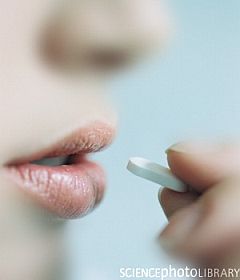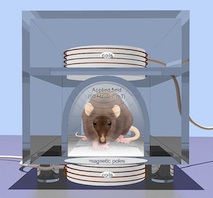
Let’s talk about the huge elephant in the living room of most depressives’ homes: the fear of treatment resistant depression. What if antidepressant medications fail to work? Are you totally screwed? Confined to a life flipping burgers, not that anything is wrong with that?
U.S. News and World Report just ran an intriguing article, “Chronically Depressed? What to Do When Antidepressants Don’t Work.” Reporter Sarah Baldauf discussed several brain stimulating techniques available to help people with treatment-resistant depression and mood disorders.
She first presents the problem we face today:
Some 27 million Americans were taking an antidepressant in 2005, more than twice the number almost 10 years earlier, thanks largely to the arrival of Prozac and other effective antidepressants with fewer side effects. But a groundbreaking 2006 trial known as STAR*D revealed that about one third of people found total relief with their first drug, and around a third were not helped even after trying several drugs and combinations.
Actually, according to the Johns Hopkins literature I’ve read, almost 70 percent of severely depressed people do recover when experimenting with a higher dose of a medication, a longer duration, a different drug, or a medication combination. But yes, only 30 percent of patients achieve remission with the first medication prescribed.
In her article, Baldauf describes how electroconvulsive therapy (ECT) has evolved from the “One Flew Over the Cuckoo’s Nest” days, and, while it was once reserved for the hopeless causes, it has become more mainstream today. It will never be risk-free, of course, given the required anesthesia, but it is much less scary than it used to be.
The even better news is that ECT is by no means the only brain stimulation therapy available to day to help treat those with chronic depressive symptoms. Baldauf explains the various kinds of brain stimulation therapies and how they work in a second piece for U.S. News and World Report called “Brain Stimulation: Can Magnetic or Electrical Pulses Help You? Targeting Misbehaving Brain Circuitry with Therapies Like ECT, DBS, and TMS.” She writes:
Medicine has long gone straight to the master organ, the brain, in an attempt to heal various psychiatric, neurodegenerative, and movement disorders. In recent years, attention has been focused heavily on the potential of brain stimulation therapies, which interrupt misbehaving brain signals. The therapies–including electroconvulsive therapy (ECT), transcranial magnetic stimulation (TMS), and deep brain stimulation (DBS)–work to rejigger the brain’s electrical circuitry and provide relief from debilitating symptoms that don’t respond to medications.
And the list of disorders these techniques could target is lengthening. Depression and Parkinson’s disease have been the subject of a considerable body of brain stimulation research, and clinical trials are now investigating the therapies to treat pain, epilepsy, Tourette’s syndrome, tinnitus, obsessive-compulsive disorder, headache, and other conditions.
Brain stimulation, also known as neuromodulation, can come in several forms. Implanted pacemakerlike devices can zap at deep parts of the brain using DBS. Strong magnets can be pressed onto a patient’s head to influence the brain’s circuitry via TMS. And controlled, seizure-inducing electrical currents can be applied to the head with ECT; intentionally causing seizures has long been used to alleviate symptoms of some mental illnesses. All those treatments offer alternatives to medications that are meant to tip the balance of neurochemicals in such a way that a tremor is controlled, say, or mania or depression is alleviated.
The brain is essentially a buzzing web of neural circuitry. Turning its electrical circuits on and off, researchers have found, has the potential to control the symptoms of diseases that emanate from the brain, says Brian Litt, whose lab at the University of Pennsylvania studies the intersection of brain network disorders and electrical engineering. (Litt is a neurologist and electrical engineer by training.) In particular, benefit has been seen with psychiatric diseases, like severe depression, and movement disorders, like Parkinson’s, in cases in which patients don’t improve on medications.
Probably the most convincing piece I’ve read, though, is this testimonial from a woman named Katherine, who experienced chronic, treatment-resistant depression. The rTMS therapy she received, through a company called Neuronetics, Inc. was able to restore her sense of joy, her desire for a full life. She writes:
I thought I would recover [from my depression] once more, and took steps to help myself, but to no avail–the treatment resistant depression was back and I was in and out of the most severe emotional pain I have ever felt.
It was at this pivotal point that Neuronetics, Inc. came into my life. I had known for a number of years that rTMS–repetitive transcranial magnetic stimulation–was being actively researched for use in the treatment of depression. In layman’s language, magnets were being used to transmit tiny amounts of energy to the specific portion of the brain where the chemicals affecting depression are located. It seemed to me then that this would be a superior method of coaxing the brain to do its job more efficiently. I knew I needed a different approach than the traditional ones. Serendipity was on my side also, as the research had just been approved by the FDA for use on patients with treatment-resistant depression.
The typical protocol for these treatments calls for four to six weeks of treatments five days a week. After that there is a taper off period in which less treatments are received each week. Compared to all other medical treatments I have received, this one has been easy, comfortable, with minimal discomfort (a small feeling of hurt felt only by those like me who have a very low pain threshold). One even gets to watch a movie while the treatment is in progress.
So, I just want to encourage those depressives out there who haven’t been able to recover fully from depression or another mood disorder: Please don’t lose hope. The technologies today, I believe, will afford more and more people the chance to experience joy and peace. At least that is my deepest wish.
* Click here to subscribe to Beyond Blue and click here to follow Therese on Twitter and click here to join Group Beyond Blue, a depression support group. Now stop clicking.

